BY JANET STEINBERG
“Namaste”.
With palms together in a prayer-like gesture, friendly Thai people may welcome you with that traditional Thai greeting.
However, Namaste is not always the ordinary everyday greeting.
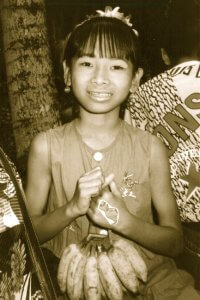
THAI BEAUTY GREETS TRAVELERS WITH BANANAS SHE WAS SELLING
But nothing is ordinary about Bangkok, the capital and most populous city of Thailand… not the ancient ruins, not the gilded temples and not the ever-smiling people. This “Venice of the East”, is a potpourri of superlatives. It is the best and the worst… the most beautiful and most slovenly… the most chaotic and most serene. It is the classiest and the sleeziest… the most exotic and the most commonplace.
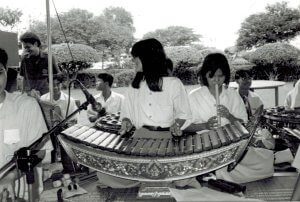
NOTHING IS ORDINARY ABOUT BANGKOK
What’s a wat? That is one of the questions most often asked in Thailand. No, it’s not a silly comic routine like the one made famous by the comedy duo of Bud Abbott and Lou Costello. (In 1999,Time magazine named the Abbott & Costello routine the “Best Comedy Sketch of the 20th Century”.) A wat, and there are over 23,000 of them in Thailand, is a Buddhist Temple… a monastery where monks reside. In daily use by over 90% of the predominately Buddhist population, some not-to-be-missed wats include the following:
WAT ARUN, The Temple of the Dawn, is best viewed in the morning when the sun’s rays dance on the pieces of colored glass and Chinese porcelain imbedded in its 218-foot spire.
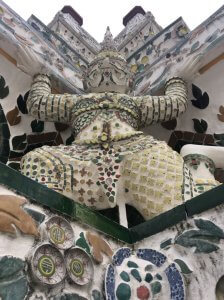
SUN’S RAYS DANCE ON WAT ARUN’S MOSAICS
WAT PHRA KAEO, the Temple of the Emerald Buddha houses the Emerald Buddha that was carved from a single block of jade. This protector of the kingdom, and the most revered figure in Thailand, is the most visited temple in Bangkok.
WAT TRAIMIT houses the Golden Buddha that had been concealed beneath a stucco covering for centuries. On May 25, 1995, it was accidentally discovered when dropped during a move to a new building. The stucco cracked revealing the solid gold image weighing 5.5 tons.
WAT PHRA JETUPON (“WAT PO”) is the oldest and largest temple in Bangkok. Here lies the Reclining Buddha, the huge image which depicts the dying Buddha as he was about to reach Nirvana some 2000 years ago.
WAT SUTHAT sits by the 69-foot tall Giant Swing (Sao Chingcha) that has become one of the most photographed and historically important tourist attractions in Bangkok.
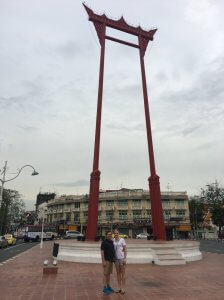
TRAVELERS ARE PHOTOGRAPHED BY THE GIANT SWING THAT SITS ATOP A STONE SLAB
The Klong Show, also known as The Floating Market, is an absolute must for visitors to Bangkok. Long-tail boats ply the canals (called klongs) and offer sights you will see no other place in the world. Photograph the colorful food sellers as they hawk their delicious-smelling morsels from their boats, but dine on safer authentic Thai cuisine at the storied Spice Market in the Regent Hotel Bangkok since 1983. Designed to resemble a charming old Thai spice shop, the restaurant invites you to explore endless shelves of ingredients before dining on dishes that focus on Central Thai cuisine.
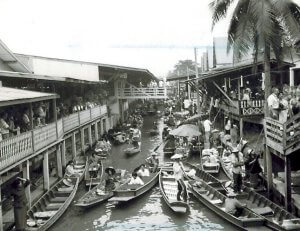
LONG-TAIL BOATS AND VISITORS CROWD THE KLONG SHOW AT THE FLOATING MARKET
The Rose Garden, located approximately 20 miles west of Bangkok amid the rural scenery along the Nakhon Chaisri River, is a cultural center where you’ll experience all things Thai. The Thai Cultural Village offers Thai boxing and martial arts, folk dancing, ritual ceremonies and sword fighting. Elephants can be seen working as they still do in the teak forests of Northern Thailand.
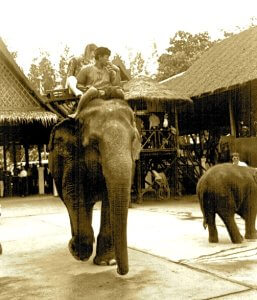
EXPERIENCE THAI CULTURE AT THE ROSE GARDEN
Bangkok, after dark, has something for everyone. From the ear-splitting, mind-boggling sights of Patpong Road (the sex-for-sale street of bars and massage parlors) to a cultural dinner show at the Oriental Hotel’s Sala Rim Naam, a Thai pavilion located on the opposite bank of the Chao Phraya River just across from the hotel. Along with your meal of delicately spiced Thai food, you will enjoy the court dances of ancient Siam.
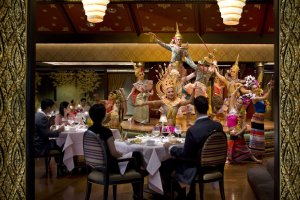
CULTURAL DINNER SHOW AT THE ORIENTAL’S SALA RIM NAAM
The Oriental Hotel, considered by many to be the greatest hotel in the world, sits regally enthroned on the banks of Bangkok’s Chao Phraya–the fabled “River of Kings”. Time and the Chao Phraya flow endlessly on, but Asia’s Grande Dame still sits in serene splendor upon the same shores where it has occupied its celebrated position since mid-19th century. The original Oriental burned down, was demolished and rebuilt around 1875. In 1894, management was assumed by Louis Leonowens, son of the royal Siamese household’s governess Anna, who was immortalized in “The King and I”.
The original Oriental Hotel, unquestionably the most famous hotel in Thailand, belonged to a period of Thailand’s history that is gone forever. Well-known travelers such as Somerset Maugham and Noel Coward stayed at the Oriental because, at that time, it was the only hotel in the city with any claim to modern Western conveniences. Today, past guests such as Mick Jagger, Lloyd Bridges and Andrew Lloyd Weber chose The Oriental because it was the only hotel in the city with any claim to the 19th Century.
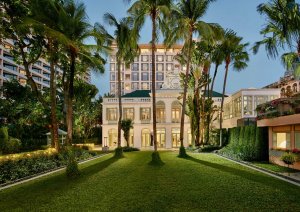
THE ORIENTAL HOTEL AT DUSK
The Oriental’s first wing was built in 1876, with a modern tower being added to the old colonial-style building in 1958. The need to continue the thread of tradition and preserve the atmosphere of those less hurried times was one of the main challenges facing the architects. The thought of tearing down the original structure and erecting a new building on the empty site never even occurred to the architect. The irreplaceable could never be replaced.
The colonial-style lobby of the original wing is a charming respite from the blazing, bustling streets of Bangkok. Known as the Authors’ Lounge, it embodies the old-world charm of the Oriental at its best. There is a dignified and solemn atmosphere for those who love to surround themselves with the dark, delicious serenity of the ancient Thai life. The Jim Thompson Suite is appropriately named in memory of one of its former owners, the legendary “Thai Silk King” Jim Thompson. The magnificent Thai silks in the suite were designed and woven for the suite by Jim Thompson’s original weaver.
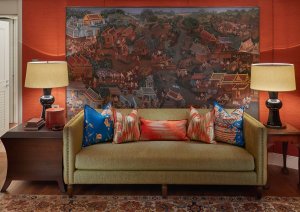
JIM THOMPSON SILKS ADORN THE SUITE HONORING HIS NAME
The Grand Old Lady of the Chao Phraya River, renowned for her ambiance of timeless colonial-style elegance in an exotic Eastern setting, still maintains the same traditions of graceful living and unobtrusive service which has built her reputation over 147 years.
Every great city has one great hotel. In Bangkok, it’s The Oriental.
Janet Steinberg, winner of 55 national travel-writing awards resides in Cincinnati but calls the world her home.
